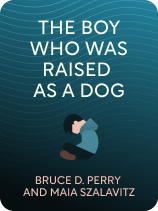

This article is an excerpt from the Shortform book guide to "The Boy Who Was Raised as a Dog" by Bruce D. Perry and Maia Szalavitz. Shortform has the world's best summaries and analyses of books you should be reading.
Like this article? Sign up for a free trial here.
What effect does the caregiver-infant interaction have on a child? What’s the role of the caregiver in supporting infant development?
Caregiver-infant interaction is the primary way that an infant learns how to handle stress, and good interactions lay the foundation for healthy coping skills later on in life. Understanding how this works can make you a better caregiver.
Discover how caregiver-infant interaction impacts an infant’s experience of stress and comfort.
The Stress Response in Infancy
The caregiver-infant interaction lays the neural foundations for coping with and regulating stress later in life. When we’re infants, every new stimulus is stressful, including things as basic and essential as physical touch or hunger. A vital part of infant development is receiving care that teaches us how to respond to and process these new stimuli (or stressors).
(Shortform note: In The Happiest Baby on the Block, pediatrician Harvey Karp explains that human babies are born with an underdeveloped nervous system, making them less capable of coping with the stimuli of the world outside the womb. He argues that this is because humans can’t healthily remain pregnant for the length of time it would take for babies to develop their nervous systems further (which he suggests would take an additional trimester in the womb). This helps explain why human babies seem to struggle more with new stimuli than other animals do. It may also explain why babies can be soothed with behaviors that help simulate the womb, such as swaddling, shushing, and rocking.)
When an infant’s stress response system is activated, it cries—a reaction that’s designed to elicit a response from caregivers who attend to the infant’s needs. For example, if the infant is hungry, the caregiver responds by feeding; if the infant is afraid or uncomfortable, the caregiver soothes them with holding, cooing, and rocking. These behaviors relieve the infant’s stress response by determining the source of the distress and then eliminating it.
This interaction creates an association in the infant’s brain between social interaction with the caregiver and an activation of the reward centers in their brain, resulting in a feeling of pleasure. This association is what makes us enjoy and crave social interaction, and it’s essential for developing empathy (as we’ll discuss later). If the infant doesn’t receive the proper caregiving response, they won’t develop these associations. This can have both immediate and long-term consequences, such as the failure to attach to a caregiver or the inability to relate to others later in life.
(Shortform note: Attachment theory suggests that the way a caregiver responds to their infant’s needs can determine how that infant attaches to other people throughout the rest of the child’s life. Children whose parents are consistently responsive to their distress signals learn that they can rely on their parents to attend to their needs. Such children tend to develop secure attachments, which make it easier for them to form healthy relationships later in life by trusting others and expressing their emotions. On the other hand, neglectful care, inconsistent care, or abuse in infancy can all result in insecure attachment styles that make it more difficult to form close and healthy relationships later.)
| Balancing Caregiver Attentiveness Parents often worry about spoiling their babies with too much affection, but experts argue that withholding attention from your baby when they’re distressed makes them more needy and keeps them from developing skills like resilience and self-sufficiency. One expert suggests that infants who go unsoothed experience uniquely terrifying sensations because of their helplessness and lack of understanding of the world: the feeling of falling endlessly, the feeling of dying, and the loss of hope that they’ll ever be comforted. Some parenting advice—particularly surrounding sleep training—centers around allowing a baby to “cry it out,” or cry until they stop on their own rather than comforting or soothing them. The research on this practice is mixed, with some studies suggesting it can help babies sleep longer and more deeply, while others suggest it just teaches babies not to cry when they need attention— though the “cry it out” method alone is not likely to have extreme consequences unless the infant is left to cry for hours on end with no caregiver response. But the “cry it out” method generally advises letting your infant cry only for a certain amount of time before responding to them. |

———End of Preview———
Like what you just read? Read the rest of the world's best book summary and analysis of Bruce D. Perry and Maia Szalavitz's "The Boy Who Was Raised as a Dog" at Shortform.
Here's what you'll find in our full The Boy Who Was Raised as a Dog summary:
- How trauma impacts the developing brains of children
- Case studies of child abuse and neglect, as told by a child psychiatrist
- An explanation of the Neurosequential Model of Therapeutics






